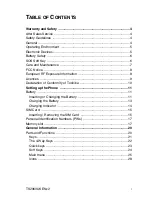
The FCC has granted an Equipment Authorization for this model phone with all reported SAR levels evaluated
as in compliance with the FCC RF exposure guidelines. SAR information on this model phone is on file with the
FCC and can be found under the Display Grant section of www.fcc.gov/oet/ea/fccid after searching on FCC ID:
SRQ-Z353VL.
For this device, the highest reported SAR value for usage against the head is 0.49 W/kg, for usage near the
body is 0.96 W/kg.
While there may be differences between the SAR levels of various phones and at various positions, they all meet
the government requirements.
SAR compliance for body-worn operation is based on a separation distance of 0.6 inches (15 mm) between
the unit and the human body. Carry this device at least 0.6 inches (15 mm) away from your body to ensure RF
exposure level compliant or lower to the reported level. To support body-worn operation, choose the belt clips
or holsters, which do not contain metallic components, to maintain a separation of 0.6 inches (15 mm) between
this device and your body.
RF exposure compliance with any body-worn accessory, which contains metal, was not tested and certified, and
use such body-worn accessory should be avoided.
FCC Regulations
This device complies with part 15 of the FCC Rules. Operation is subject to the following two conditions: (1) This
device may not cause harmful interference, and (2) this device must accept any interference received, including
interference that may cause undesired operation.
This equipment has been tested and found to comply with the limits for a Class B digital device, pursuant to part
15 of the FCC Rules. These limits are designed to provide reasonable protection against harmful interference
in a residential installation. This equipment generates, uses and can radiate radio frequency energy and, if not
installed and used in accordance with the instructions, may cause harmful interference to radio communications.
However, there is no guarantee that interference will not occur in a particular installation. If this equipment does
cause harmful interference to radio or television reception, which can be determined by turning the equipment
off and on, the user is encouraged to try to correct the interference by one or more of the following measures:
• Reorient or relocate the receiving antenna.
• Increase the separation between the equipment and receiver.
• Connect the equipment into an outlet on a circuit different from that to which the receiver is connected.
• Consult the dealer or an experienced radio/TV technician for help.
CAUTION: Changes or modifications not expressly approved by the manufacturer could void the user’s authority
to operate the equipment.
Hearing Aid Compatibility (HAC) Regulations for Mobile Phones
In 2003, the FCC adopted rules to make digital wireless telephones compatible with hearing aids and cochlear
implants. Although analog wireless phones do not usually cause interference with hearing aids or cochlear implants,
digital wireless phones sometimes do because of electromagnetic energy emitted by the phone’s antenna, backlight,
or other components. Your phone is compliant with FCC HAC regulations (ANSI C63.19-2011).
While some wireless phones are used near some hearing devices (hearing aids and cochlear implants), users
may detect a buzzing, humming, or whining noise. Some hearing devices are more immune than others to this
interference noise, and phones also vary in the amount of interference they generate. The wireless telephone
industry has developed ratings for some of their mobile phones to assist hearing device users in finding phones
that may be compatible with their hearing devices. Not all phones have been rated. Phones that have been rated
General Safety
Radio Frequency (RF) Energy
This phone is designed and manufactured not to exceed the emission limits for exposure to radio frequency (RF)
energy set by the Federal Communications Commission of the United States.
During SAR testing, this device was set to transmit at its highest certified power level in all tested frequency
bands, and placed in positions that simulate RF exposure in usage against the head with no separation, and near
the body with the separation of 0.4 inches (10 mm). Although the SAR is determined at the highest certified
power level, the actual SAR level of the device while operating can be well below the maximum value. This is
because the phone is designed to operate at multiple power levels so as to use only the power required to reach
the network. In general, the closer you are to a wireless base station antenna, the lower the power output.
The exposure standard for wireless devices employs a unit of measurement known as the Specific Absorption
Rate, or SAR. The SAR limit set by the FCC is 1.6 W/kg.
This device complies with SAR for general population/uncontrolled exposure limits in ANSI/IEEE C95.1-1992
and has been tested in accordance with the measurement methods and procedures specified in IEEE1528.
Don’t make or receive handheld calls while
driving. Never text while driving.
Don’t use at gas stations.
Keep your phone at least 15 mm away from
your ear or body while making calls.
Your phone may produce a bright
or flashing light.
Small parts may cause choking.
Don’t dispose of your phone in fire.
Your phone can produce a loud sound.
To prevent possible hearing damage,
do not listen at high volume levels for
long periods.
Avoid contact with anything magnetic.
Avoid extreme temperatures.
Keep away from pacemakers and other
electronic medical devices.
Avoid contact with liquids.
Keep your phone dry.
Power off when asked to in hospitals and
medical facilities.
Don’t take your phone apart.
Power off when told to in aircrafts and
airports.
Only use approved accessories.
Power off when near explosive materials
or liquids.
Don’t rely on your phone for
emergency communications.




































